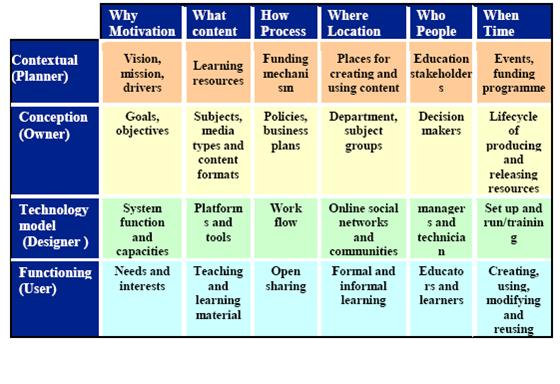At the CAL 2009 conference in Brighton last week, I gave a presentation entitled “Developing a Framework for Understanding and Evaluating the Impact of Open Educational Resources”. This presentation was partly based on Adam’s blog about Open Educational Resources and the Zachman Framework as well as some of the latest thinking and discussions on the rapid development of intuitional OER initiatives internationally as well as JISC/HEA pilot OER funding programme with colleagues at CETIS. Given the complexity of the OER initiative itself and the nature of the transformation process of the OERs, we need a more structured way to capture different views and expectations from various players involved in the OER development process and a useful tool to examine institutional strategies in relation to OER approach and their impact on current and future practice in HE.
Zachman framework is the most widely known framework in the Enterprise Architecture context and it is designed to address the complexity and transformation process in enterprise architecture and examines the key business, information, application and technology strategies and their impact on business functions. Applying the Zachman approach, I derived an analytical framework for OERs and it is illustrated below:

 In the table, the four rows present different points of view from various players related to OERs, namely: the planner, owner, designer and user. The information provided in each cell could become knowledge to help us share and understand different perspectives from different players in the process. For example, the motivation factor, requires the planner, owner, designer and user to come up with answers to the “why” question, i.e. why is there a need for OER? Why are the various choices made? It concerns the translation of goals and strategies into specific ends and means.
In the table, the four rows present different points of view from various players related to OERs, namely: the planner, owner, designer and user. The information provided in each cell could become knowledge to help us share and understand different perspectives from different players in the process. For example, the motivation factor, requires the planner, owner, designer and user to come up with answers to the “why” question, i.e. why is there a need for OER? Why are the various choices made? It concerns the translation of goals and strategies into specific ends and means.
In the first row, the planner identifies the education vision and mission in relation to OER in general. In the second row, these are translated into the specific goals and objectives that apply to an institution’s operation. In the third row, they are converted to technical capacity and constraint. Finally, in the fourth row, they become specific project functions which meet the user’s needs and interests. The same process applies to the other questions.
The major implication of the framework is its explicit recognition that OERs are developed by distinct groups with different point of views. These views include a social policy perspective, an organisation and business oriented perspective, a technical perspective and a social cultural and pedagogical perspective. It is important to bridge the gaps between the perspectives and this is the key towards institutional transformation. Therefore, from the beginning, we should be recognizing these are different views and expectations; from the beginning, we should be dealing with multiple players, locations and requirements and so on As a result, a shared perspective of OER can be produced answering “why, what, when, where, who, and how” at the planning stage of the programme. The framework also allows ownership of activities and data to be established, and these should be traced throughout the programme and appropriately integrated in the development process. Furthermore, the framework provides a potential mechanism for a detailed analysis of the OER programmes. It can provide a rich picture of what it is the programme about so that we can construct our explanations of an OER initiative in the appropriate context and find out what works for whom in what condition.